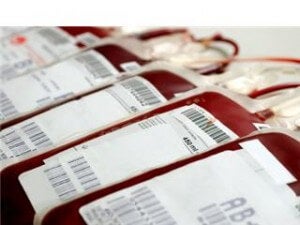
As if you didn’t have enough to worry about, now you’ve got to figure out if storing your child’s umbilical cord blood might just save his or her life. With the advent of amazing and clinically tested stem cell treatments, today’s expecting parents are faced with the real possibility that their child may one day require a stem cell transplant. Umbilical cords, with a host of hematopoietic (blood-developing) stem cells, may be puffy tubes filled with the equivalent of medical miracles. So, to store or not to store, that is the question. Let’s take a look at the benefits, costs, likely uses, and possible alternatives to freezing the umbilical cord blood of your baby. There’s a video about the collection method itself, after the break.
Here’s a short list of horrible illnesses that your child could develop and that might keep you awake at night: leukemia, lymphoma, aplastic anemia, severe sickle cell anemia, immune deficiencies, and heart disease. Each of these disasters are can be treated with hematopoietic stem cells. While you could get these cells from a bone marrow transplant, an umbilical cord allows a child to provide it’s own donation. So, if you chose to store your child’s cord blood, and he or she gets hit by one of the above disasters, you may be on your way to the ‘most cautious and loving parent award.’
Would you gamble with your baby’s life? [Cue dramatic music]
It really all comes down to numbers. The chances of your child developing any one of these diseases in their youth may be as high as 1 in 5000 or possibly much greater. Some of these diseases, such as types of anemia, may require a donor other than the patient. In these cases, cord blood would be useless unless it belonged to a sibling. Parents who already have a child with a disease will likely store a new baby’s cord blood to help save the first child. As Hollywood loves to remind us, some parents get pregnant with donation in mind.
In most other cases, parents choosing to save the umbilical blood are really just hedging their bets against catastrophe. You could say its a different kind of health insurance. Those who want to take the extra precaution can do so. The rest will just roll the dice and take their chances. It’s that simple, right?
C’mon Singularity Hub reader, you should know that we’re all about helping you beat the odds and cheat death. First, you shouldn’t be relying on dumb luck. Working with a genome sequencing company, like 23andMe, can provide a cheap(ish) method to discovering if you and your mate have genetic markers that indicate an increased risk for certain diseases. With the proper genetic screening, you’ll see if your future baby’s chances are more like 1 in 5 or 1 in 5 million. These tests aren’t free, but they’d certainly help you decide if storing cord blood is worth the costs, and it’s information you may want to know anyway.
How do you collect cord blood? A private bank, Viacord, posted this helpful video on YouTube.
Let’s get down to some more numbers: $1000-$2000 for setting up an account, more than $100 per year for storage, hundreds for collection costs. That’s your minimum bill for storing cord blood. Depending on your financial situation, these prices may seem anything from a bargain to highway robbery. You should expect that storage will last 10-15 years. After that, you may not need the cells anymore.
Not that your child’s risk of severe illness goes down at age fifteen, sadly the opposite is true. No, it’s just that the few ounces of blood in the cord are suitable to developing enough stem cells for a baby or small child. When you’re little bundle of joy hits puberty, size becomes an issue. Of course, in ten or fifteen years scientists may be able to reliably multiply stem cells indefinitely. In that case, you may be storing that cord blood for a long time.
Can anyone give me a straight answer? …Not really, no.
The future won’t just see the possibility of multiplying stem cells, it may see the multiplication of their uses as well. The list of disasters that could be solved by hemapoietic cells could potentially get much longer. The general use of stem cells may expand as well. Stem cell treatments for diabetes, which affects almost 8% of children in the US, have had success. Arteriocyte and other companies are figuring out how to use cord cells to produce enough red blood cells for a traditional blood donation. Dr. Ralf Sodian of the University Hospital of Munich was able to develop completely new heart valves from umbilical cord stem cells in 2008 (that’s amazing!) The list of possible uses goes on and on.
On the other side of the coin, the possible risks of harvesting cord blood are not well understood either. While people have been saving cord blood since the 1970s, no one can say for certain if an infant will be adversely affected by the collection. We know the risks for lower blood volume and anemia aren’t zero, but we can’t predict what future research may reveal about the importance of an infant getting all their cord blood. I should point out that in a non-collection delivery, cords are often cut quickly, so many infants may not normally get their tube of blood anyway.
Public vs. Private Cord Blood Banks

Just to make things more complicated, you also have the option of donating your child’s cord blood. Like bone marrow, cord blood has the chance of saving another child’s life. Cord blood donors don’t even have to be a perfect match because the stem cells in the cord are naive (undeveloped). The American Academy of Pediatricians (AAP) doesn’t recommend universal private storage of cord blood because the possibility of autologous use seems small, and as such, they don’t consider it a wise investment. AAP and the National Marrow Donor Program, however, recognize that donating cord blood is a sure way to help treat children who are suffering from leukemia and other diseases in the disaster list. As we mentioned above, some illnesses can’t be treated by your own stem cells. Sharing cord blood, rather than storing it against a rainy day, may be a more useful choice. Certain races and ethnicities are in special need of cord donation because of limited supplies. This is a common problem in all manner of donations.
Many public cord blood banks will cover the collection costs if you choose to donate your child’s cord. They save some money by only having to store the cord for a short time (the need is that high). Many private banks will test and add your child’s cord blood information onto the national database while still storing it for your personal use. In that way, you could keep the cells for your child if he or she needs it, and if they do not need it you can match the blood to a needy recipient.
Donating your child’s cord blood isn’t all about saving lives, however. 50% of all donations are not even stored. Many collected cord blood bags do not contain enough stem cells to adequately serve as a transplant (this affects private storage as well). Others are donated to science for research. Actually, that leads to lives being saved too, but not in the ‘here’s a picture of the child you helped’ sort of way.
Yeah, ask the blogger, I’m sure he knows what to do.
So here’s how I break it down:
- The chances of your child ever needing his or her cord blood is small right now. You can use genetic testing to help you inform your decision, but at some level it’s going to remain a crapshoot.
- The costs of storing umbilical blood privately is on the order of $3000-$4000 total (collection fees, initiation fees, storage costs for around ten to fifteen years).
- The risks of harvesting an umbilical cord are small, but not zero. Undiscovered risks are always a possibility just like undiscovered benefits.
- Those undiscovered benefits will continue to grow as medical research explores the uses of stem cells. However, there’s no guarantee that umbilical cord cells would be preferred or even necessary in such treatments.
- There is a current need for cord blood donation. Whether for science or for little kids with leukemia, your child’s blood could make a difference. It could also get tossed in the garbage because it didn’t contain enough stem cells.
Doing a cost benefit analysis will be easier for some than others. Many simply do not have four grand to spare when starting their families. For those of you with large disposable incomes and a baby on the way, I can see how the choice may be more difficult. Since I have no idea how to make money nor babies I am saved from that dilemma. If you are facing this choice, best of luck and try to keep in mind that some stem cell treatments will certainly be available to all children, cordless or otherwise.
In the interest of full disclosure I should mention that I am an advocate of donation. I donate blood, will likely donate organs upon my death (not really in my control, of course) and generally encourage others to do the same. My expressed opinions do not necessarily reflect the opinions of Singularity Hub or its owners, or even reality, and you should feel free to dismiss this whole article as a rant for body-fluid and body-part socialism. ¡Viva la Singularidad!


